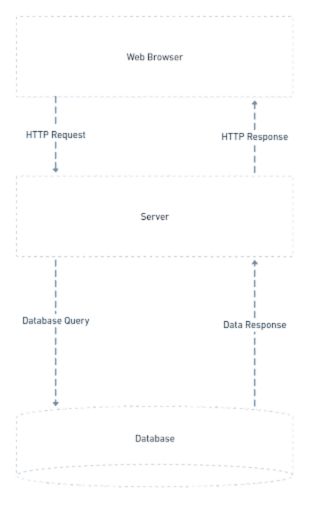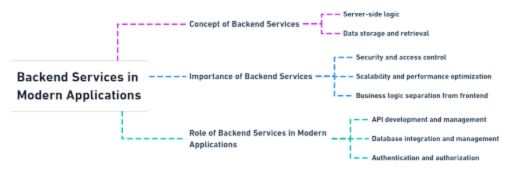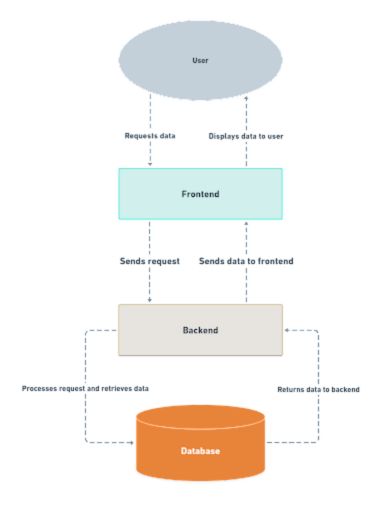
In the vast landscape of modern technology, the term “backend services” often emerges in discussions surrounding applications and websites. But what exactly are backend services, and why are they crucial in today’s digital age? In this beginner’s guide, we’ll unravel the mysteries behind backend services, exploring their concept, importance, and role in powering the digital experiences we encounter daily.
What Are Backend Services?
To understand backend services, let’s first break down the components of a typical digital application. When you interact with an app or website, you’re often engaging with two main parts: the frontend and the backend. The frontend is what you see and interact with—the user interface, buttons, forms, and other visual elements. On the other hand, the backend operates behind the scenes, handling tasks such as data storage, processing user requests, and communicating with other systems.
Backend services encompass the collection of server-side functionalities that power an application’s logic and data processing. These services handle tasks like user authentication, database management, business logic implementation, and integration with external services or APIs. In essence, the backend serves as the engine that drives the entire application, working tirelessly to ensure smooth operations and deliver valuable services to users.
Importance Of Backend Services
Now that we understand what backend services are, let’s explore why they’re indispensable in modern applications:
Data Management: Backend services are responsible for storing and managing data efficiently. Whether it’s user information, product details, or application settings, the backend ensures that data is securely stored, organized, and accessible when needed.

Business Logic Implementation: Backend services encapsulate the business logic—the rules and processes that govern how an application operates. From processing payments and managing inventory to orchestrating complex workflows, backend services translate business requirements into functional code.

Security and Authentication: Backend services play a critical role in implementing security measures such as user authentication and authorization. They validate user credentials, enforce access controls, and safeguard sensitive data from unauthorized access or malicious attacks.
Scalability and Performance: As applications grow and user demands evolve, backend services must scale to handle increased traffic and workload. By employing scalable architectures and performance optimization techniques, these services ensure that applications remain responsive and reliable, even under heavy loads.
Integration and Interoperability: In today’s interconnected ecosystem of applications and services, backend services facilitate seamless integration with external systems, APIs, and third-party services. This interoperability enables applications to leverage a wide range of functionalities and deliver enhanced user experiences.
Role Of Backend Services In Modern Business Applications
In the dynamic landscape of modern applications, backend services serve as the backbone that powers innovation and drives digital transformation. From e-commerce platforms and social media networks to cloud-based productivity tools and IoT applications, backend services form the foundation upon which diverse digital experiences are built.
Whether you’re ordering groceries online, streaming your favorite music, or collaborating with colleagues on a shared document, backend services work tirelessly behind the scenes, ensuring that applications deliver value, reliability, and security to users worldwide.
Use Case: Simple Todo List Backend Service
Imagine you’re creating a basic todo list application. Users can create, read, update, and delete tasks from their todo lists. Your backend service will handle storing and managing these tasks.
Here’s how the backend service for this todo list application might function:
Data Storage: The backend service stores todo list tasks in a database. For simplicity, let’s consider using a lightweight database like SQLite, although in production, you might opt for a more robust solution like PostgreSQL or MongoDB.
API Endpoint Design: The backend service exposes a set of API endpoints that allow clients to perform CRUD (Create, Read, Update, Delete) operations on tasks. For example:
GET /tasks: Retrieve all tasks.
GET /tasks/{id}: Retrieve a specific task by its ID.
POST /tasks: Create a new task.
PUT /tasks/{id}: Update an existing task.
DELETE /tasks/{id}: Delete a task.
Request Handling: When a frontend client sends a request to one of the API endpoints (e.g., via an HTTP request from a web or mobile app), the backend service receives the request and parses it to determine the desired action (e.g., retrieve tasks, create a new task).
Data Processing: Depending on the requested action, the backend service performs the necessary operations on the todo list tasks. For example, if the request is to create a new task, the service inserts the task into the database. If the request is to retrieve tasks, the service queries the database to fetch the relevant data.
Response Formatting: After processing the request and interacting with the database, the backend service formats the response data (e.g., the retrieved tasks or a success/error message) into a standardized format such as JSON or XML and sends it back to the frontend client.
Error Handling: The backend service includes error-handling logic to handle situations such as invalid requests, database errors, or other exceptional conditions. It returns appropriate HTTP status codes and error messages to the client to indicate the outcome of the request.
Security: Although we’re keeping this example simple, in a real-world application, you’d also consider security measures such as authentication and authorization to ensure that only authorized users can access and manipulate their todo lists.
By implementing a backend service for the todo list application, you provide a centralized and scalable solution for managing tasks. This separation of concerns allows you to easily update and maintain the backend logic independently from the frontend, making it easier to add new features or scale the application as needed.

Conclusion
In conclusion, backend services play a pivotal role in modern applications, providing the essential functionalities and infrastructure needed to deliver seamless digital experiences. From data management and security to scalability and integration, backend services are the unsung heroes that power the applications we rely on every day.
As we continue to embrace digital innovation and explore new frontiers of technology, understanding the importance of backend becomes increasingly vital. By demystifying the complexities behind the scenes, we gain a deeper appreciation for the role that backend services play in shaping the digital world around us.
In the upcoming blog posts, we’ll delve deeper into specific aspects of backend development, exploring topics such as API design, database management, and scalability strategies. Stay tuned as we embark on this journey to unravel the intricacies of backend services and empower you to build robust and efficient Digital Solutions.


